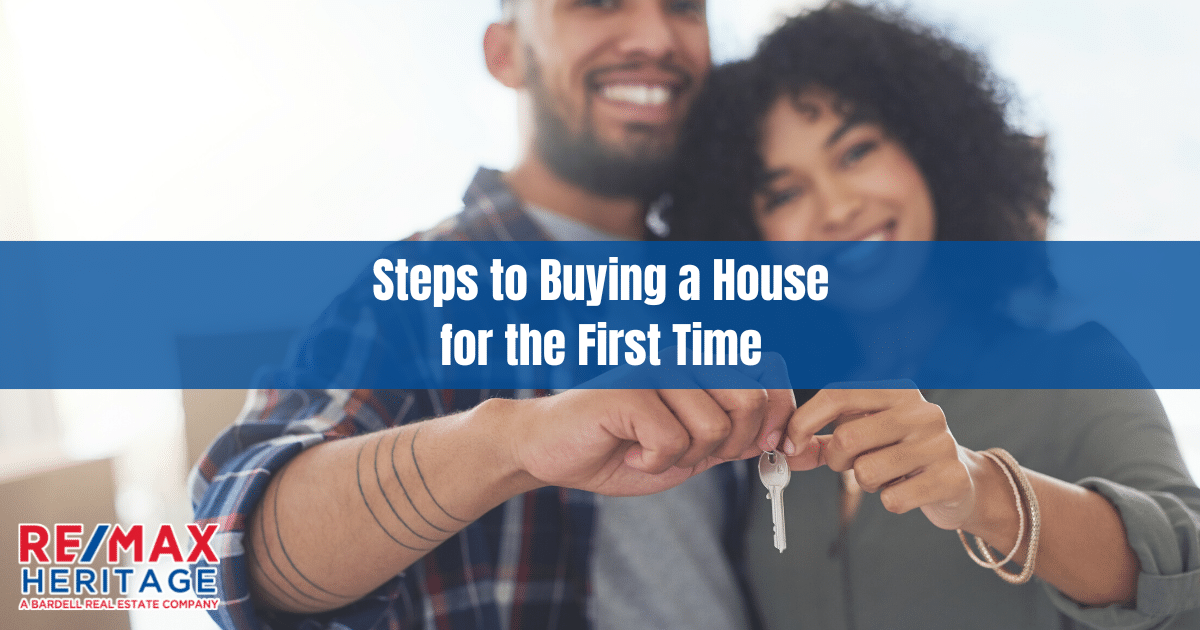Steps to Buying a House for the First Time


Steps to Buying a House for the First Time
The steps to buying a house for the first time might seem complicated—particularly if you’re a home buyer trying to purchase real estate with no prior experience. Between down payments, credit scores, mortgage rates (both fixed-rate and adjustable-rate), property taxes, interest rates, and closing the deal, it’s easy to feel overwhelmed. There’s so much at stake with a first home!
Still, if you familiarize yourself with what it takes to buy your first home beforehand, it can help you navigate the real estate market with ease. So let’s get started!
Ready to buy a house? Follow these steps to buying a house for the first time
In this step-by-step guide, you’ll learn what it takes to buy your first home, from beginning to end. Whether it’s your first time in the real estate market or you’re an experienced homeowner who wants to brush up on your skills, this is everything you need to know about how to buy a house.
Step 1: Start saving a down payment
One of the most important steps to buying a house for the first time? Figure out your finances. Buying a new home (particularly for the first time) requires a mortgage, where a lender fronts you the money and you pay it back over time. However, in order to get a mortgage, you’ll need some sort of down payment.
So how much do you need?
Ideally a down payment on a mortgage should be 20% of the home’s price to avoid added fees, but if you don’t have that much of a down payment, don’t worry. A mortgage down payment can be as low as 10%, 5%, or even 0% for certain types of mortgages (e.g., VA loans or a USDA loan).
If saving up a downpayment is a real challenge, find out everything you can about government programs. A HUD home is a property owned by the U.S. Department of Housing and Urban Development. They require lower down payments for eligible participants, and often sell at below market prices.
Step 2: Check your credit score
Did you forget to pay off a couple of credit cards? Unfortunately, it’ll affect your credit score.
In addition to having a down payment, a first-time home buyer will need a decent credit score. This three-digit number is a numerical summary of your credit report, a detailed document outlining how well you’ve paid off past debts like for credit cards and college student loans.
A lender will check your score and report in order to estimate the odds that you will deliver your monthly payment, too.
In turn, the lender will use this info to decide whether or not to loan you money, as well as how much and at what interest rate. If a lender sees some late payments on your credit cards or other blemishes in your credit report, this can lower your odds of getting a loan with a great interest rate, or perhaps even jeopardize your chances of getting any loan at all.
So it’s essential to know your credit score, and take steps with those overextended credit cards and high-interest debts to bring your credit score up to snuff.
Step 3: Get pre-approved for a mortgage
Another one of the most important first-time home buyer steps? Seeking pre-approval from a lender for a home loan. This is where you meet with a loan officer, ideally a few at various mortgage companies.
Each mortgage lender will scrutinize your financial background—such as your debt-to-income ratio and assets—and use this info to determine whether to loan you money, and what size monthly payment you can realistically afford. This will help you target homes in your price range. And that’s good, because a purchase price that’s beyond your financial reach will make you sweat your mortgage payment and puts you at risk of defaulting on your loan.
As a buyer, just keep in mind that mortgage pre-approval is different from mortgage pre-qualification. Pre-qualify, and you’re undergoing a much simpler process that can give you a ballpark figure of what you can afford to borrow, but with no promise from the lender. Getting pre-approved is more of a pain since you’ll have to provide tons of paperwork, but it’s worth the trouble since it guarantees you’re creditworthy and can truly buy a home.
Step 4: Find a real estate agent
Want a trusty home-buying guide by your side? Most first-timers will want a great real estate agent—specifically a buyer’s agent, who will help them find the right houses, negotiate a great real estate deal, and explain all of the nuances of home buying along the way.
The best part? The agent’s services are free to first-time home buyers (because the seller pays the sales commission).
Note: There is a subtle difference between a real estate agent and a Realtor®; the latter is a member of the National Association of Realtors® and adheres to a code of ethics. Consider having a Realtor additional insurance that you’ll get the help you need to ace the process.
Step 5: Go shop for a home!
This is the fun part! As a home buyer, you can peruse thousands of real estate listings on sites such as realtor.com, then ask your agent to set up appointments to see your favorites in person.
Since the sheer number of homes can become overwhelming, it’s best to separate your must-haves from those features you’d like, but don’t really need. Do you really want a new home or do you prefer a fixer-upper? Make a list of your wants and needs to get started, and whittle down your options.
Step 6: Make an offer
Found your dream home? Then it’s time to make an offer to the seller. Be prepared to write a check to the seller—it’s called “earnest money,” and it’s different than the deposit.
Here’s more on how to make an offer on a house that a seller can’t refuse.
Step 7: Get a home inspection
A home inspection is where you hire a home inspector to check out the house from top to bottom to determine if there are any problems with it that might make you think twice about moving forward. Think: termites, faulty foundation, mold, asbestos, etc. Sure, a lot can go wrong, but rest assured that most problems are fixable.
Step 8: Get a home appraisal
Even if you got pre-approved for your home loan, your lender will want to conduct a home appraisal. This is where the lender checks out the house to make sure it’s a good investment. It’s similar to a home inspection, but for your lender.
Step 9: Head to closing
Closing, which in different parts of the country is also known as settlement or escrow, brings together a variety of parties who are part of the real estate transaction, including the buyer, seller, mortgage representative, and others.
Closing is the day you officially get the keys to your new home—and pay all the various parties involved. That will include your down payment for your loan, plus closing costs, the extra fees you pay to process your loan.
Closing costs can be sizable, averaging anywhere from 2% to 7% of the home price.
Step 10: Move in!
Done with closing? Got your loan? Congratulations, you’ve officially graduated from a home buyer to a homeowner! See, the long-term process of buying a first home wasn’t so scary after all, right? Now it’s time to kick back and enjoy the many benefits of becoming a homeowner.
Experts in Residential Real Estate in Orlando
If you are BUYING or SELLING real estate it’s quiet often the single most important financial decision you make. For the last 30 years we have helped clients buying and selling property in Orlando and the surrounding areas. Put simply, this means the knowledge and expertise accumulated over this time ensures our clients get the best representation possible.
Our experienced agents will help and guide you through the entire process providing valuable support every step of the way.
Ready to make a Move?
Bardell Real Estate are the experts in helping you with your selling, buying or renting needs near Orlando, Florida. Make your Disney area experience a forever memorable one. Call us now to speak to a real estate agent.
[formlift id=”36911″]
